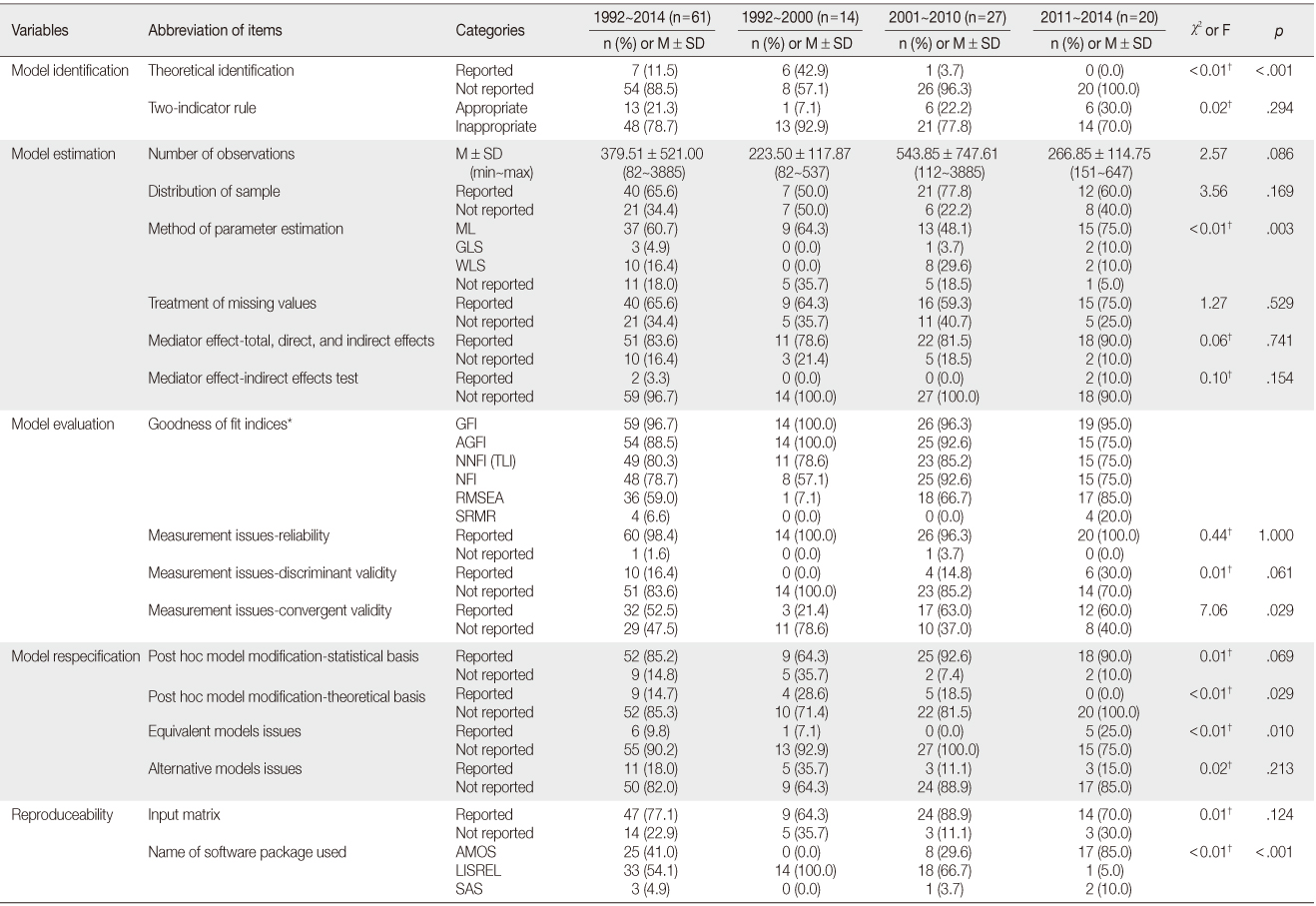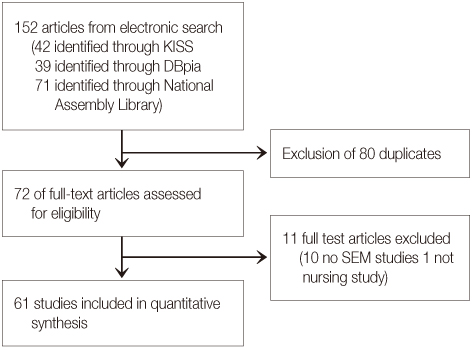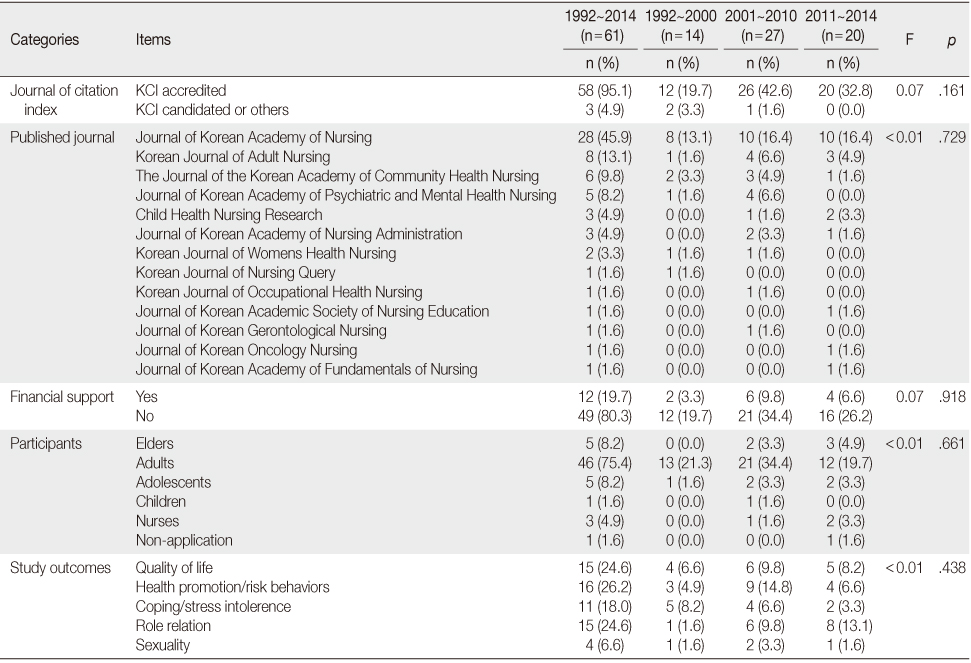Articles
- Page Path
- HOME > J Korean Acad Nurs > Volume 45(2); 2015 > Article
-
Review Article
- A Methodological Quality Assessment of South Korean Nursing Research using Structural Equation Modeling in South Korea
- Jung-Hee Kim, Sujin Shin, Jin-Hwa Park
-
Journal of Korean Academy of Nursing 2015;45(2):159-168.
DOI: https://doi.org/10.4040/jkan.2015.45.2.159
Published online: April 30, 2015
1Department of Nursing, College of Health Sciences, Dankook University, Cheonan, Korea.
2Department of Nursing, College of Medicine, Soonchunhyang University, Cheonan, Korea.
3College of Nursing·The Research Institute of Nursing Science, Catholic University of Daegu, Daegu, Korea.
- Address reprint requests to: Park, Jin-Hwa. College of Nursing, Catholic University of Daegu, 33 Duryugongwon-ro 17-gil, Nam-gu, Daegu 705-718, Korea. Tel: +82-53-650-4754, Fax: +82-53-650-4392, parkjh07@cu.ac.kr
© 2015 Korean Society of Nursing Science
This is an Open Access article distributed under the terms of the Creative Commons Attribution NoDerivs License. (http://creativecommons.org/licenses/by-nd/4.0/) If the original work is properly cited and retained without any modification or reproduction, it can be used and re-distributed in any format and medium.
Abstract
-
Purpose
- The purpose of this study was to evaluate the methodological quality of nursing studies using structural equation modeling in Korea.
-
Methods
- Databases of KISS, DBPIA, and National Assembly Library up to March 2014 were searched using the MeSH terms 'nursing', 'structure', 'model'. A total of 152 studies were screened. After removal of duplicates and non-relevant titles, 61 papers were read in full.
-
Results
- Of the sixty-one articles retrieved, 14 studies were published between 1992 and 2000, 27, between 2001 and 2010, and 20, between 2011 and March 2014. The methodological quality of the review examined varied considerably.
-
Conclusion
- The findings of this study suggest that more rigorous research is necessary to address theoretical identification, two indicator rule, distribution of sample, treatment of missing values, mediator effect, discriminant validity, convergent validity, post hoc model modification, equivalent models issues, and alternative models issues should be undergone. Further research with robust consistent methodological study designs from model identification to model respecification is needed to improve the validity of the research.
- 1. Martens MP. The use of structural equation modeling in counseling psychology research. Couns Psychol. 2005;33(3):269–298. ArticlePDF
- 2. Mueller RO. Structural equation modeling: Back to basics. Struct Equ Modeling. 1997;4(4):353–369. Article
- 3. Kim J, Hong S, Choo B. Applications of structural equation modeling in management studies: A critical review. Korean Manage Rev. 2007;36(4):897–923.
- 4. Lee GS, Yom YH. Structural equation modeling on life-world integration in people with severe burns. Asian Nurs Res. 2013;7(3):112–119. Article
- 5. Kline RB. Principles and practice of structural equation modeling. 3rd ed. New York, NY: Guilford Press; 2011.
- 6. Lim NY, Kang HS, Lee SE, Suh YO, Kwon YE. The trend of Korean nursing research with the LISREL. J Korean Acad Nurs. 2001;31(2):221–231.ArticlePDF
- 7. Weston R. A brief guide to structural equation modeling. Couns Psychol. 2006;34(5):719–751. ArticlePDF
- 8. Baumgartner H, Homburg C. Applications of structural equation modeling in marketing and consumer research: A review. Int J Res Mark. 1996;13(2):139–161. Article
- 9. Boomsma A. Reporting analyses of covariance structures. Struct Equ Modeling. 2009;7(3):461–483. Article
- 10. Breckler SJ. Applications of covariance structure modeling in psychology: Cause for concern? Psychol Bull. 1990;107(2):260–273.ArticlePubMed
- 11. Hoyle RH, Panter AT. Writing about structural equation models. In: Hoyle RH, editor. Structural equation modeling: Concepts, issues, and applications. Thousand Oaks, CA: Sage; 1995. p. 158–176.
- 12. MacCallum RC, Austin JT. Applications of structural equation modeling in psychological research . Annu Rev Psychol. 2000;51:201–226. ArticlePubMed
- 13. McDonald RP, Ho MH. Principles and practice in reporting structural equation analyses. Psychol Methods. 2002;7(1):64–82.ArticlePubMed
- 14. Raykov T, Tomer A, Nesselroade JR. Reporting structural equation modeling results in psychology and aging: Some proposed guidelines. Psychol Aging. 1991;6(4):499–503.ArticlePubMed
- 15. Steiger JH. Driving fast in reverse: The relationship between software development, theory, and education in structural equation modeling. J Am Stat Assoc. 2001;96(453):331–338.
- 16. Cho HD. A study on issues of using structure equation modeling in education study [master's thesis]. Seoul, Korea University. 2011.
- 17. Bentler PM, Chou CP. Practical issues in structural modeling. In: Long JS, editor. Common problems/proper solutions: Avoiding error in survey research. Newbury Park, CA: Sage; 1988. p. 161–192.
- 18. Moon SB. Basic concepts and applications of structural equation modeling with AMOS 17.0. Seoul: Hakjisa; 2009.
- 19. Yu JP. The misunderstanding and prejudice of structural equation models. Seoul: Hannare Publishing Co.; 2014.
- 20. Holbert RL, Stephenson MT. Structural equation modeling in the communication sciences, 1995-2000. Hum Commun Res. 2002;28(4):531–551. Article
- 21. Shook CL, Ketchen DJ Jr, Hult GTM, Kacmar KM. An assessment of the use of structural equation modeling in strategic management research. Strategic Manage J. 2004;25(4):397–404. Article
- 22. Polit DF, Beck CT, Owen SV. Is the CVI an acceptable indicator of content validity? Appraisal and recommendations. Res Nurs Health. 2007;30(4):459–467. ArticlePubMed
- 23. Kim KMJ, Cha YN, Jang HS, Han HS, Chung JS, Yoon J, et al. NANDA nursing diagnosis, goals and interventions. Seoul: Hyunmoon; 2013.
- 24. Chen F, Bollen KA, Paxton P, Curran PJ, Kirby JB. Improper solutions in structural equation models: Causes, consequences and strategies. Sociol Methods Res. 2001;29(4):468–508.
- 25. Jöeskog KG, Söbom D. LISREL 7: A guide to the program and applications. 2nd ed. Chicago, IL: SPSS Inc.; 1989.
- 26. Mitchell RJ. Path analysis: Pollination. In: Scheiner SM, Gurevitch J, editors. Design and analysis of ecological experiments. 2nd ed. New York, NY: Chapman and Hall; 1993. p. 211–231.
- 27. Arbuckle JL. Full information estimation in the presence of incomplete data. In: Marcoulides GA, Schumacker RE, editors. Advanced structural equation modeling: Issues and techniques. Mahwah, NJ: Lawrence Erlbaum Associates; 1996.
- 28. Enders CK, Bandalos DL. The relative performance of full information maximum likelihood estimation for missing data in structural equation models. Struct Equ Modeling. 2001;8(3):430–457. Article
- 29. Schreiber JB. Core reporting practices in structural equation modeling. Res Social Adm Pharm. 2008;4(2):83–97. ArticlePubMed
REFERENCES
Reporting Methodological Quality of Structural Equation Model Studies in Korean Nursing Research (N =61)

*Multiple responses; †Fisher's exact test; ML=Maximum likelihood estimation; GLS=Generalized least square; WLS=Weighted least square; GFI=Goodness-of-fit index; AGFI=Adjusted goodness-of-fit index; NNFI=Non-normed fit index; TLI=Tucker-Lewis index; NFI=Normed fit index; RMSEA=Root mean square error of approximation; SRMR=Standardized root mean square residual.
Figure & Data
REFERENCES
Citations

- Influencing factors and learning outcomes in virtual simulation learning experiences: A structural equation modeling
Young Sook Roh, Kie In Jang, Elinda Ai Lim Lee
Nurse Education Today.2025; 150: 106681. CrossRef - A Review of Adolescents' Digital Self-Efficacy: Conceptualization, Measurement, Impacts, Influencing Factors, and Future Directions
Qing Tan, Wenzhuo Wu, Siying An
Journal of Current Social Issues Studies.2025; 2(5): 306. CrossRef - Translation and psychometric validation of the Korean version of the academic nurse self-efficacy scale for Korean bachelor-level nursing students
Eunkyung Lee, Jin-Hwa Park
Frontiers of Nursing.2024; 11(2): 209. CrossRef - Determining food tourism consumption of wild mushrooms in Yunnan Provence, China: A projection-pursuit approach
Jinping Lin, Bowen Zhang, Jiajia Feng, Zeyu Yi, Hao Zhang, Man Luo, Zhujun Zhong, Fei Zhao
Heliyon.2023; 9(3): e14638. CrossRef - A Structural Equation Model for Posttraumatic Growth among Cured Patients with COVID-19
Soo Young An, Heejung Choi
Journal of Korean Academy of Nursing.2023; 53(3): 309. CrossRef - Quality of Life Structural Equation Model for Patients With Amyotrophic Lateral Sclerosis
Juyeon Oh, Jung A. Kim
Rehabilitation Nursing Journal.2021; 46(5): 253. CrossRef - Predictive Model for Quality of Life of the Older Men Living Alone
Su Jin Kim, Gyeong-Suk Jeon
Journal of Korean Academy of Nursing.2020; 50(6): 799. CrossRef - A Validation Study of the Korean Version of the Jefferson Empathy Scale for Health Professionals for Korean Nurses
Hye-Ran Ryu, Kyung-Sook Bang
Journal of Korean Academy of Nursing.2016; 46(2): 207. CrossRef - Effect of universal primer on shear bond strength between resin cement and restorative materials
Nahong Kim, June-Sung Shim, Hong-Suk Moon, Keun-Woo Lee
The Journal of Korean Academy of Prosthodontics.2012; 50(2): 112. CrossRef

Figure 1
Study Characteristics (N =61)
KCI=Korea citation index.
Reporting Methodological Quality of Structural Equation Model Studies in Korean Nursing Research (N =61)
*Multiple responses; †Fisher's exact test; ML=Maximum likelihood estimation; GLS=Generalized least square; WLS=Weighted least square; GFI=Goodness-of-fit index; AGFI=Adjusted goodness-of-fit index; NNFI=Non-normed fit index; TLI=Tucker-Lewis index; NFI=Normed fit index; RMSEA=Root mean square error of approximation; SRMR=Standardized root mean square residual.
KCI=Korea citation index.
*Multiple responses; †Fisher's exact test; ML=Maximum likelihood estimation; GLS=Generalized least square; WLS=Weighted least square; GFI=Goodness-of-fit index; AGFI=Adjusted goodness-of-fit index; NNFI=Non-normed fit index; TLI=Tucker-Lewis index; NFI=Normed fit index; RMSEA=Root mean square error of approximation; SRMR=Standardized root mean square residual.
 KSNS
KSNS
 E-SUBMISSION
E-SUBMISSION


 Cite
Cite

